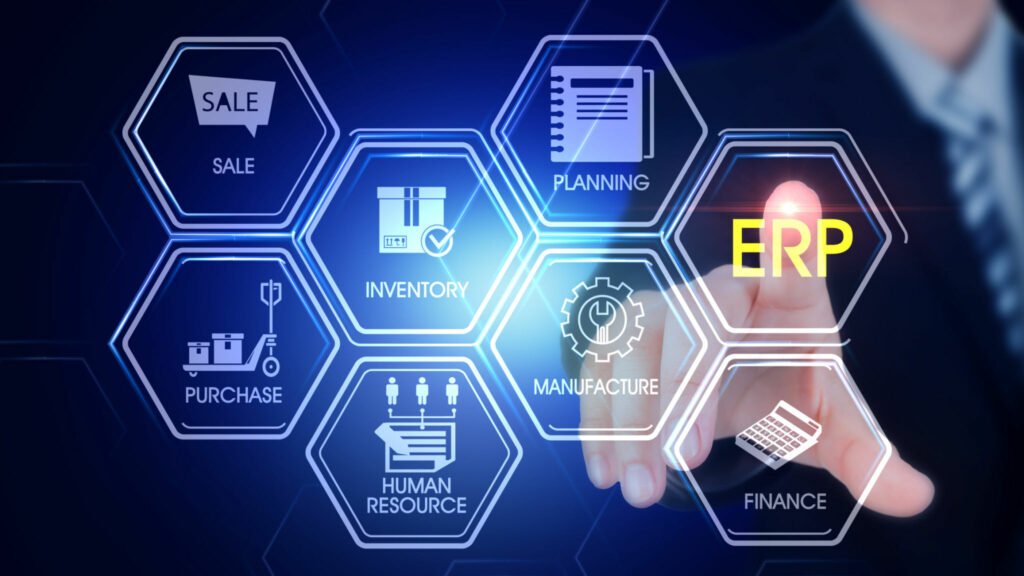
Menu

Explore our cutting-edge Enterprise Resource Planning (ERP) cloud solution, seamlessly integrating business processes and applications for enhanced resilience, real-time agility, and sustained growth.

ERP software streamlines core business tasks like accounting, procurement, risk management, and supply chain operations. It integrates processes, ensuring data consistency and eliminating duplication. Modern ERP is essential for businesses across industries, functioning as a vital operational backbone akin to electricity for powering operations.

Enterprise resource planning (ERP) software serves as a comprehensive tool for managing various daily business operations such as accounting, procurement, project and risk management, compliance, and supply chain functions. A complete ERP suite extends to encompass enterprise performance management, aiding in planning, budgeting, forecasting, and financial reporting.
These systems interconnect diverse business processes, facilitating seamless data flow among them. By consolidating an organization’s transactional data from multiple origins, ERPs streamline operations, prevent data redundancy, and ensure data accuracy through a unified source.
In today’s landscape, ERP systems play a vital role in managing businesses across diverse industries and sizes. To these enterprises, ERP stands as indispensable as the electricity powering their operations.

How do these solutions effectively handle the day-to-day operations of organizations, spanning accounting, finance, procurement, project management, supply chain, and manufacturing?
Enterprise resource planning (ERP) systems serve as comprehensive, integrated platforms, available either on-premises or in the cloud, overseeing all facets of production-oriented or distribution-based businesses. They extensively support financial management, human resources, supply chain management, and manufacturing alongside core accounting functions.
ERP systems offer transparency across your entire business process, meticulously tracking production, logistics, and financial elements. As an integrated hub, they streamline end-to-end workflows and data access for various departments.
These systems and software are versatile, catering to enterprises, mid-sized, or small businesses, and can be customized to suit specific industry needs

Though often used interchangeably, ‘financials’ and ERP software represent distinct entities within organizational systems. Financials encapsulate specific modules within ERP, focusing on finance-related functions like financial accounting, subledger accounting, payables, receivables, revenue management, and more.
These financials software modules adhere to various reporting standards set by governing bodies like IFRS, FASB (GAAP), HGB, PCG, and others, catering to regulatory obligations like SEC filings (10-Q, 10-K), ESMA, and similar bodies for public organizations, with narrative reporting tools essential for compliance. The CFO typically oversees these financials.
While financials manage the finance aspect, ERP encompasses a broader spectrum, including procurement, supply chain, inventory, manufacturing, project management, and more. It integrates with CRM solutions and incorporates advanced technologies like IoT, blockchain, AI, and machine learning, not only enhancing traditional ERP functions but also offering new opportunities for efficiency and deeper insights across enterprises. Managing ERP often involves collaboration with key executive leaders, including the CFO, CIO, COO, among others.

ERP systems revolve around a unified data structure, employing a shared database to normalize information and ensure consistent user experiences. These fundamental constructs interlink with business workflows across various departments—such as finance, human resources, engineering, marketing, and operations—to connect systems and streamline processes. Essentially, ERP serves as the mechanism for harmonizing people, operations, and technologies within a modern enterprise.
For instance, envision an automotive manufacturer sourcing parts from multiple suppliers. Utilizing an ERP system, the company tracks the requisition and procurement of these components, ensuring standardized and cohesive data throughout the procure-to-pay cycle, seamlessly tied to enterprise workflows, processes, reporting, and analytics.
In a well-implemented ERP setup at this automotive manufacturer, individual components like “front brake pads” are uniformly identified by specifications, source, lot number, supplier details, costs, and various other descriptive attributes.
Given that data forms the backbone of modern enterprises, ERP simplifies the collection, organization, analysis, and dissemination of information to support every role and function effectively.
Moreover, ERP guarantees that these data fields integrate correctly into the company’s general ledger, ensuring accurate tracking and representation of all associated costs. Consistent nomenclature across systems prevents confusion; disparate names for the same component could complicate expense assessments or supplier negotiations.
A central tenet of ERP is consolidating data for widespread access. Instead of fragmented databases and disparate spreadsheets, ERP systems bring coherence, enabling all users, from top management to operational staff, to access and employ uniform data sourced through standardized processes. With a secure centralized repository, data accuracy, currency, and completeness are assured across organizational tasks, eliminating reliance on error-prone spreadsheets for financial statements or operational reports.

The impact of ERP in today’s business landscape cannot be overstated. By consolidating enterprise data and processes into ERP systems, businesses achieve streamlined operations, aligning diverse departments and fostering significant bottom-line benefits. Specific business advantages include:

From traditional paper-based systems to the ubiquitous presence of mobile devices, the history of ERP spans over a century. In 1913, engineer Ford Whitman Harris introduced the economic order quantity (EOQ) model, laying the groundwork for paper-based manufacturing scheduling. For decades, EOQ remained the industry standard. However, in a transformative move in 1964, Black and Decker revolutionized the field by integrating EOQ principles with a mainframe computer, creating the first material requirements planning (MRP) solution.
The dominance of MRP persisted until the evolution of manufacturing resource planning (MRP II) in 1983. MRP II redefined software architecture by introducing modular systems, consolidating critical manufacturing components such as purchasing, bills of materials, scheduling, and contract management into an integrated platform. This marked the first integration of diverse manufacturing tasks into a unified system. MRP II also envisioned how organizations could utilize software to streamline operations, enhancing production planning, reducing inventory, and minimizing waste.
As computer technology advanced in the 1970s and 1980s, similar concepts emerged, expanding beyond manufacturing to encompass finance, customer relationship management, and human resources. By 1990, this integrated suite of business management software acquired a name—enterprise resource planning (ERP), signifying a holistic approach to managing diverse enterprise data and enhancing operational efficiency.

ERP Evolution: 1990s to the Turn of the Century
Throughout the 1990s until the early 2000s, ERP adoption witnessed significant growth. Simultaneously, the costs associated with implementing ERP systems surged. Companies typically housed the necessary hardware for running the software within their premises, comprising substantial machines in server rooms. Both hardware and software licenses required considerable capital investments, depreciating over 5 to 10 years. Moreover, organizations invariably sought to tailor their ERP systems to align with their specific requirements, incurring added expenses for software consultants and training.
During this period, ERP technology underwent a transformative phase, integrating internet capabilities and introducing novel features like embedded analytics. However, as time progressed, many enterprises found their on-premises ERP setups inadequate in meeting modern security standards or adapting to emerging technologies like smartphones.

Software-as-a-Service (SaaS)
Enter the realm of Software-as-a-Service (SaaS) within the cloud, particularly the ERP (Enterprise Resource Planning) delivery model. When ERP software operates as a service in the cloud, it resides on remote servers rather than within a company’s physical server space. The cloud provider handles software patches, maintenance, and regular updates multiple times a year, replacing the need for costly upgrades every 5 to 10 years as seen with on-premises systems. By embracing the cloud, operational expenses (OpEx) and capital expenses (CapEx) diminish since there’s no necessity to purchase software, hardware, or expand IT personnel. These saved resources can be redirected toward exploring fresh business prospects, ensuring the organization consistently operates on the latest ERP software. This shift allows employees to transition from IT management to more impactful endeavors like innovation and fostering growth.

Businesses, regardless of size—be it enterprise or small to midsize—face challenges in swiftly migrating from on-premises systems to a fully cloud-based infrastructure. The time constraints and comfort levels often hinder an immediate shift. Yet, persisting solely with an on-premises ERP disregards the many benefits of cloud-based enterprise resource planning. Why should you contemplate integrating cloud applications to enhance or supplant your existing on-premises system?
1. Embrace Rapidly Evolving SaaS Technologies
The emergence of next-gen tech, such as artificial intelligence (AI), empowers cloud-based systems to continuously enhance their capabilities without periodic updates, setting them apart from legacy systems. This evolution streamlines ERP management and usability seamlessly, requiring no additional input from end-users.
2. Amplify Your ERP System’s Value
Integrating cloud applications with existing legacy software enriches crucial functions, breathing new life into traditional ERP systems. This fusion presents businesses with an exceptional opportunity to embrace cloud capabilities.
3. Access Cutting-Edge Technologies
Pairing cloud applications with legacy ERP modules unlocks immediate access to advancing technologies and enhanced user experiences. These complementary systems swiftly offer valuable business capabilities without altering your operational core.
4. Reduce Reliance on Third-Party Dependencies
Cloud applications integrated with legacy ERP vendors deliver operational business intelligence akin to or better than that provided by third-party vendors, reducing external dependencies for reporting and analytics.
5. Revolutionize Financial Systems
Legacy systems lack the capacity to function as modern reporting engines. Cloud-based technology, developed with a fresh perspective and understanding of ERP needs, offers a fundamental shift in capabilities essential for modern platforms.
6. Heightened Security Measures
Cloud solution providers maintain dedicated, round-the-clock security teams, actively monitoring and addressing cloud security concerns, offering robust protection unmatched by on-premises solutions.
7. Appeal to Top Talent
Recruiting the next generation of tech-savvy talent necessitates a modern, mobile-friendly work environment. Companies anchored solely in on-premises technology risk missing out on attracting top talent, irrespective of age.

Businesses, regardless of size—be it enterprise or small to midsize—face challenges in swiftly migrating from on-premises systems to a fully cloud-based infrastructure. The time constraints and comfort levels often hinder an immediate shift. Yet, persisting solely with an on-premises ERP disregards the many benefits of cloud-based enterprise resource planning. Why should you contemplate integrating cloud applications to enhance or supplant your existing on-premises system?
Organizations have long grappled with the intricate balance between traditional ERP’s costly complexity and the necessity for tailored features, all while meeting business demands. Discover how Cubefore’s ERP Cloud unites teams, harmonizes data, and offers real-time insights, enabling you and your finance team to make informed, strategic decisions. Delivered as a service in the cloud, our ERP ensures your organization remains agile and ahead of the curve.
The beauty of the Software as a Service (SaaS) model lies in its continual updates with the latest features and practices. Cloud ERP providers, like Oracle, routinely introduce updates—sometimes monthly—granting subscribers access to cutting-edge technologies like AI, digital assistants, machine learning, blockchain, augmented reality, and the Internet of Things (IoT).
Access to these innovations allows swift enhancement of business practices as the ERP software evolves. Tasks once heavily reliant on manual efforts, such as financial account reconciliation, become automated. Moreover, users gain a comprehensive, real-time grasp of enterprise operations, extending from the front office to warehouses, factory floors, and beyond, accessible on mobile devices like smartphones and tablets for every relevant employee.
Tailored for the digital era, today’s ERP cloud integrates mobile, social, analytics, and the latest technologies. Anything less fails to drive organizational progress in this dynamic landscape.
Ans. ERP stands for enterprise resource planning. It’s a software system that integrates essential tools and processes needed to effectively manage various aspects of a business, such as HR, manufacturing, supply chain, finance, and accounting, among others.
Ans. The three most common types of ERP systems include on-premises, cloud-based, and hybrid ERP. On-premises ERP operates within a company’s servers on-site, while cloud-based ERP functions on a third-party remote server. Hybrid ERP combines both, typically utilizing on-premises ERP at the central office and cloud-based ERP systems at subsidiary locations.
Ans. An instance of an ERP system includes industry-specific variations tailored to meet unique business demands. These specialized ERPs offer industry-specific capabilities such as materials planning and dedicated manufacturing records management. Their tailored features often alleviate the need for extensive customization or integration with multiple external tools.
Understanding your needs and goals is our priority. We collaborate closely, listening to your vision to craft an unparalleled experience together.

Receive Tailored Solutions, Recommendations, and Estimates.

Expect a Call from One of Our Account Managers Shortly.
Understanding your needs and goals is our priority. We collaborate closely, listening to your vision to craft an unparalleled experience together.

Receive Tailored Solutions, Recommendations, and Estimates.

Expect a Call from One of Our Account Managers Shortly.